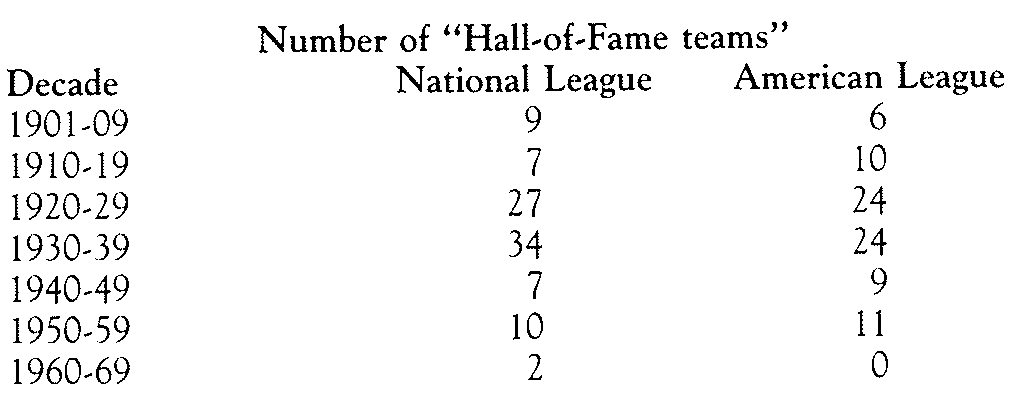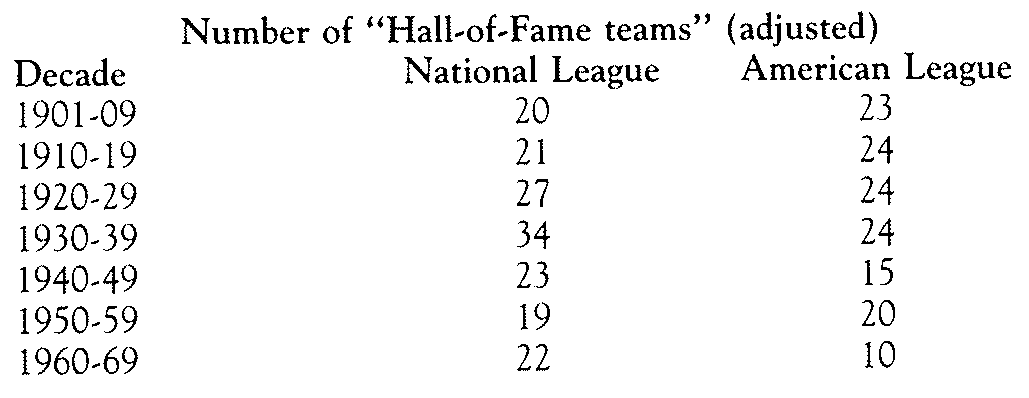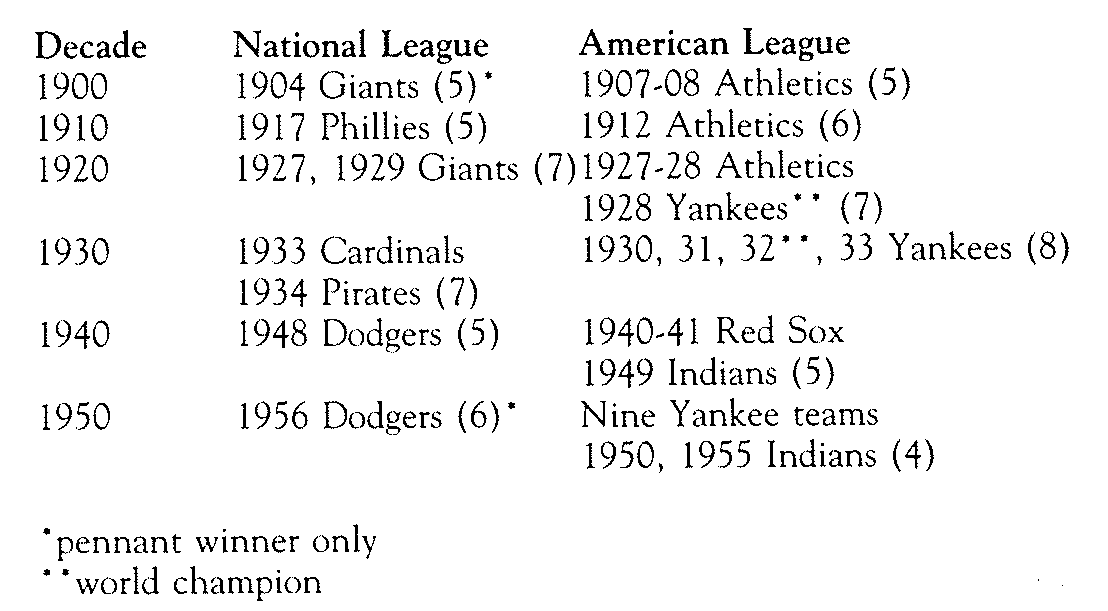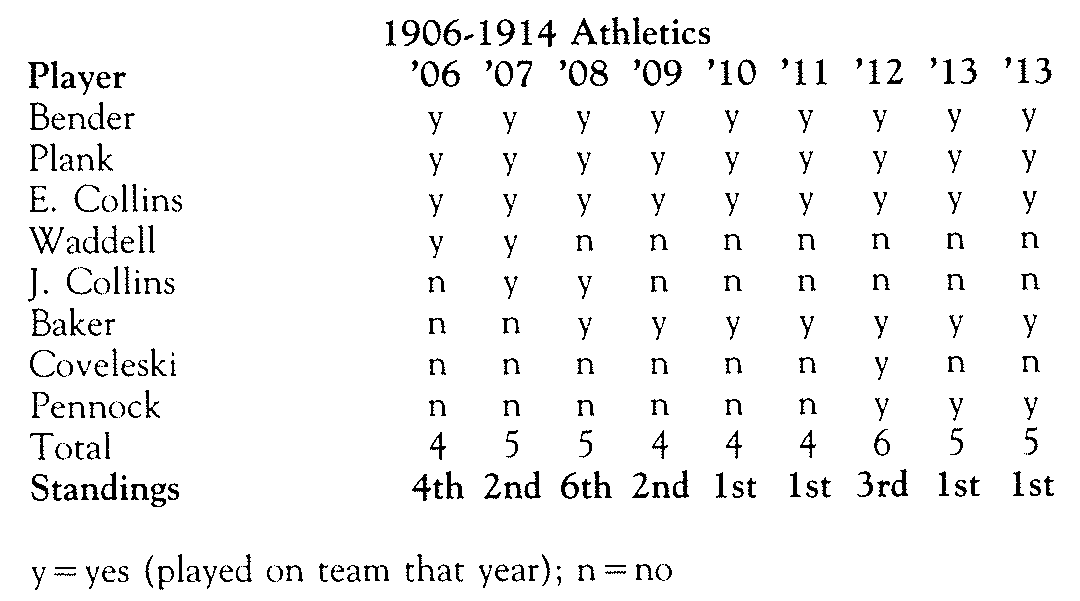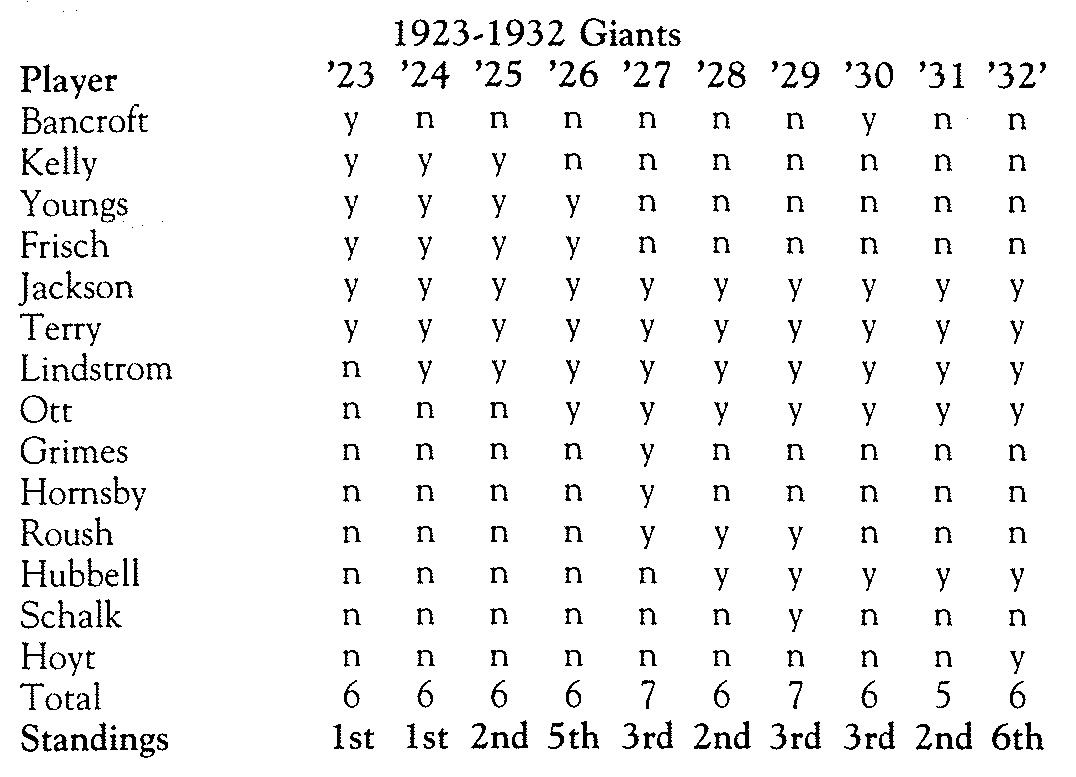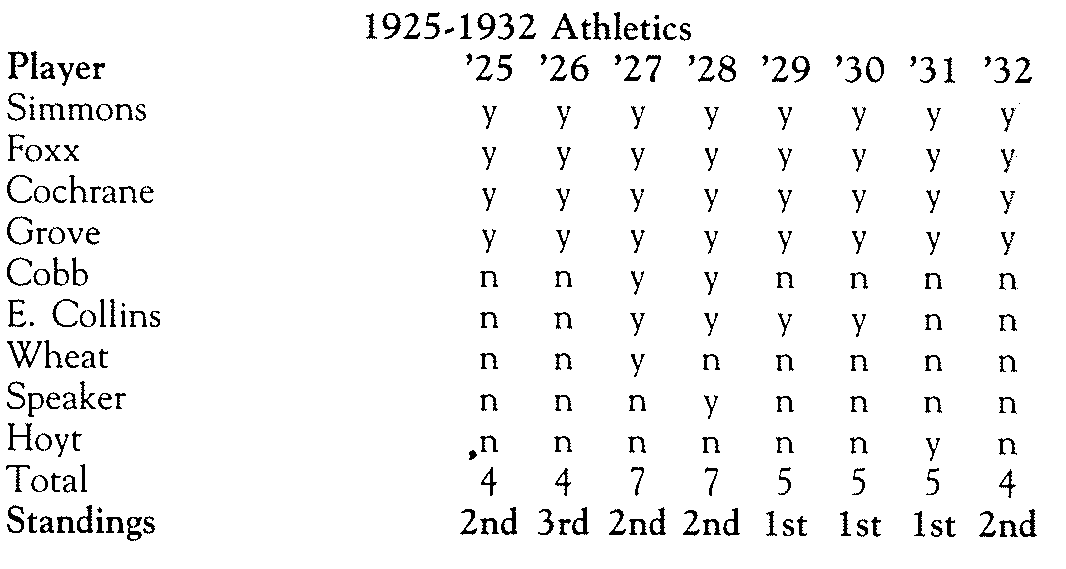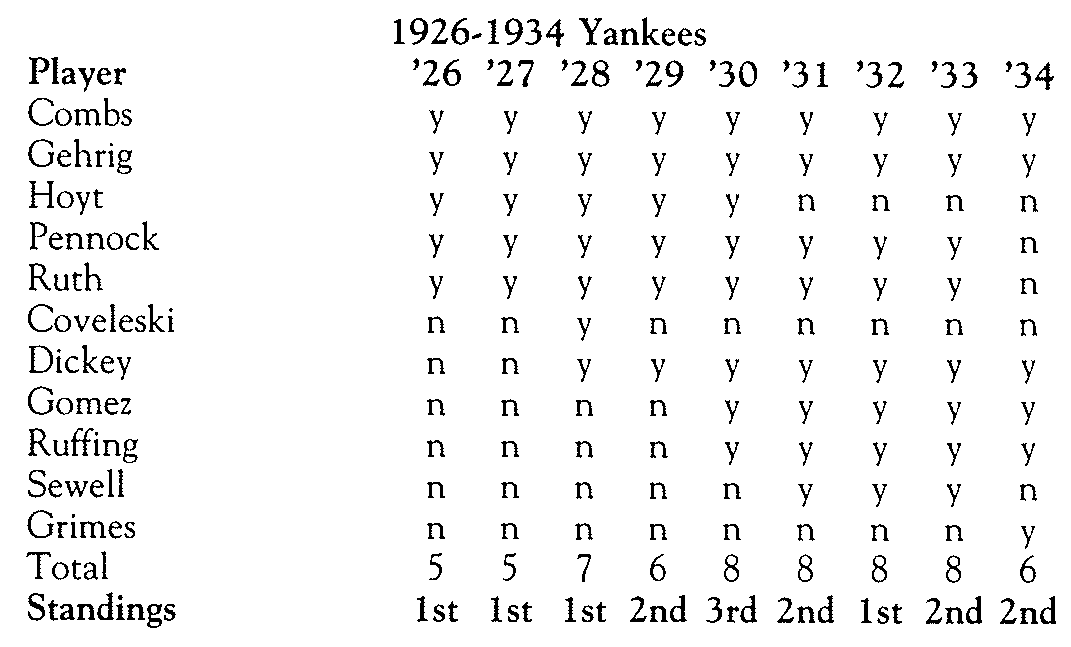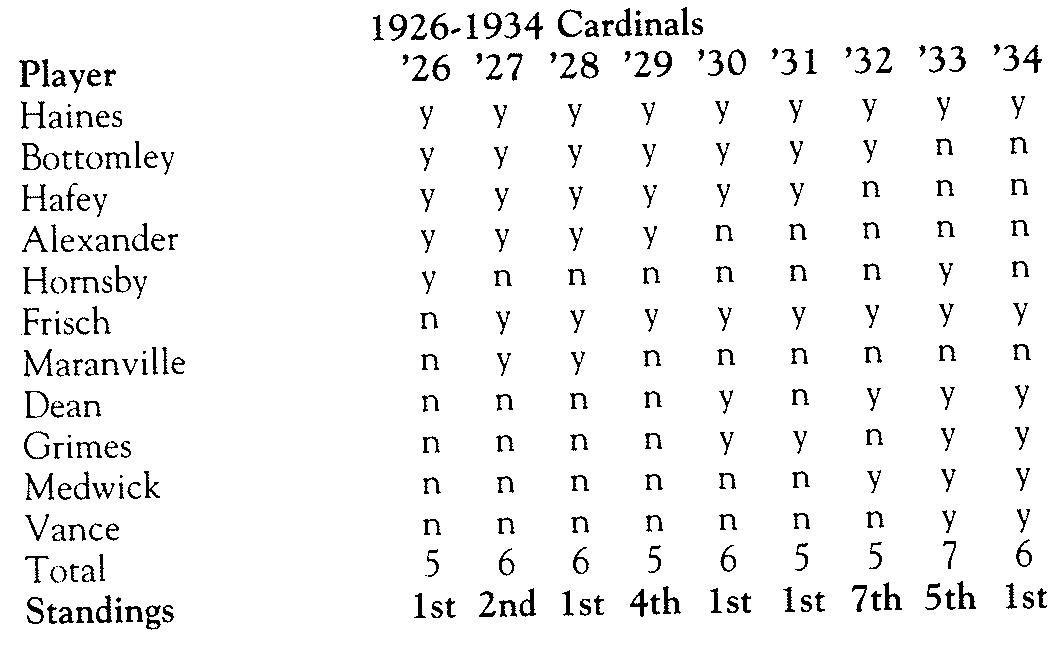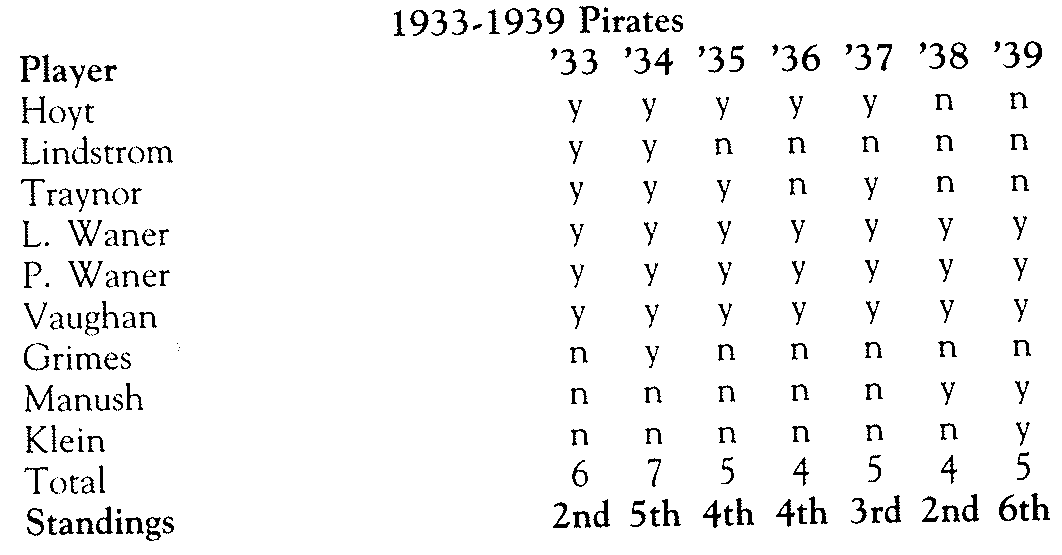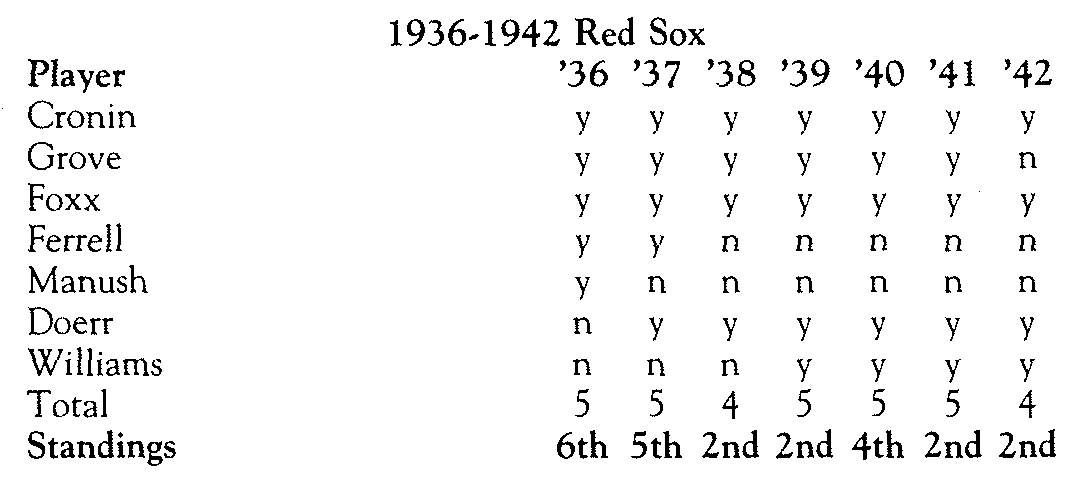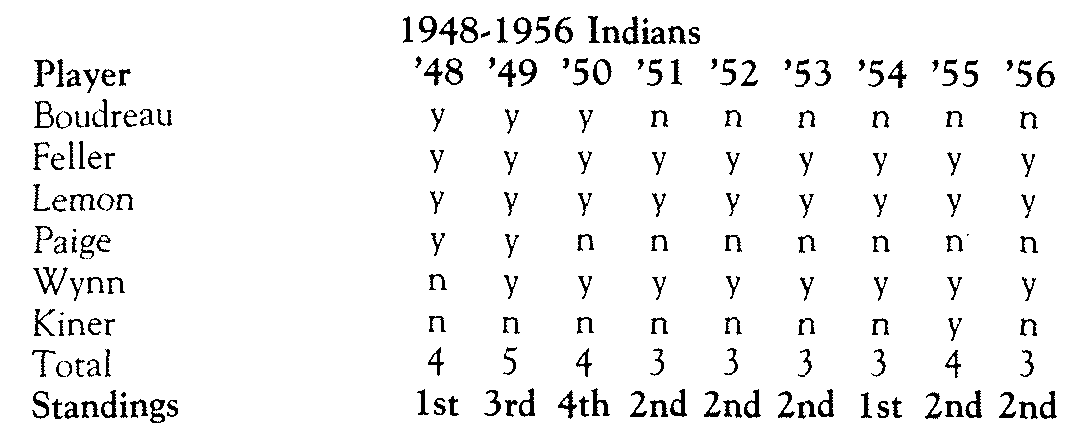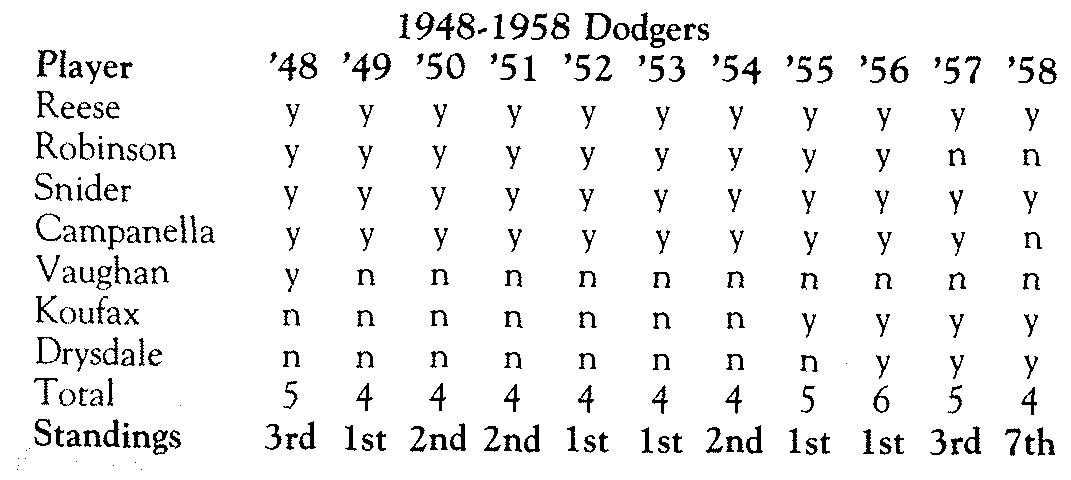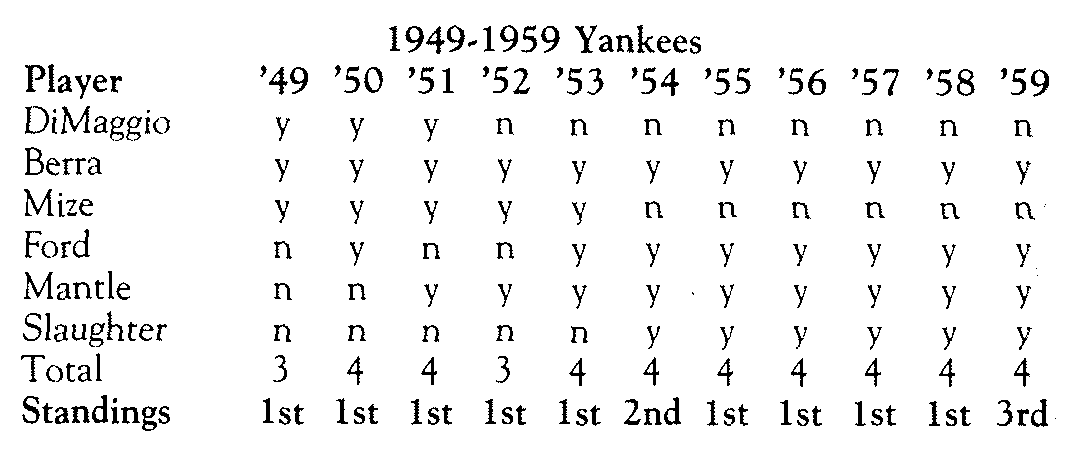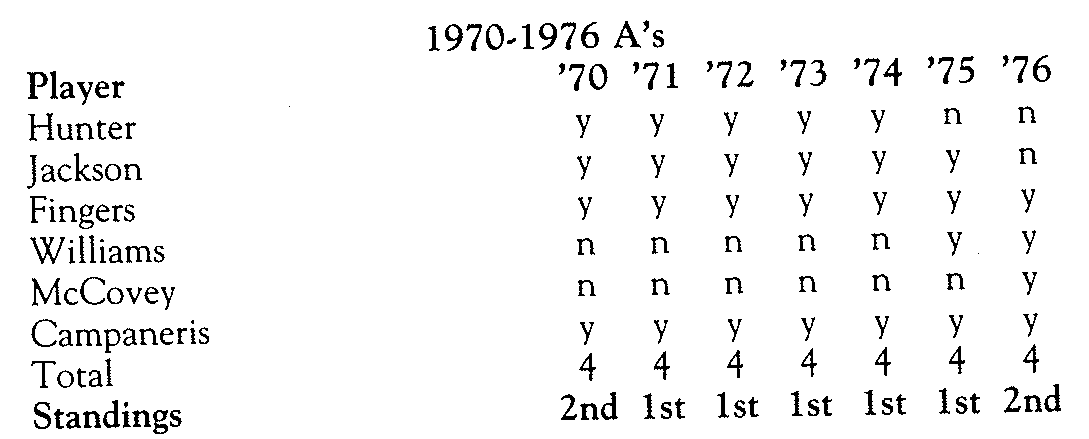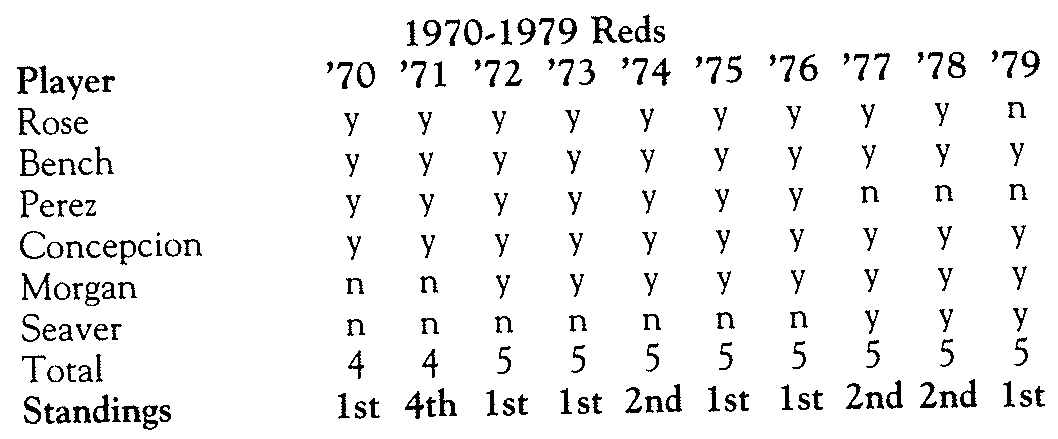Hall of Fame Teams: Study in Paradox
This article was written by Jeremy Giller - Henry Berman
This article was published in 1989 Baseball Research Journal
The more Hall of Famers a team owns, the more championships it wins, right? Research suggests a far different picture. For one thing, those Famers may be finished.
ALTHOUGH MUCH IS WRITTEN about Hall of Fame players, little is written about the teams they have played on together. Fans who know the answer to questions like, “Which teams have won (or lost) the most games?” or “Which teams have hit the most home runs?” don’t know which teams had the most Hall-of-Fame players and how well those teams did. This article will answer these questions, and discuss some of the interesting teams that we studied in the process of doing this analysis. It also will show that, with extraordinarily few exceptions, the teams with the most future Hall of Famers were not successful teams. They were rarely championship teams, and seldom even won pennants; a number finished in the second division.
We gathered our data by studying all National and American League teams from 1901 to the present; although a case can be made for including teams before 1901, we felt we had more consistency by restricting our study to the “modern baseball era.” The last teams with Hall of Famers, through 1988, were the 1983 Red Sox and Red (Carl Yastrzemski and Johnny Bench), preceded by the 1982 Pirates (Willie Stargell), the 1980 Giants (Willie McCovey), and the 1979 Yankees (Catfish Hunter). Hall of Famers who played after 1969 were so few that we ended our study that year, although at the end of the article we will look at some of the great teams of the 1970s, to see how many future Hall of Famers they may have had.
Seventy-eight times a team has had five Hall of Famers for at least part of the season. Four of these had eight such players: the 1930-33 Yankees. A look at these four teams demonstrates two points: The first, not surprisingly, is the Hall’s preponderance of players from the late 1920s and early 1930s, presumably because of that era’s inflated batting averages. The other, very surprisingly, is the lack of direct correlation between having many Hall of Famers and outstanding success. Although 1930-33 fall within the Yankee dynasty years (1921-1964), the Yanks won only one pennant during those years (1932). Their world championship teams of 1936 through 1939, in contrast, had “only” five Hall of Famers.
Seven teams had seven Hall of Famers: the 1927 and 1929 Giants; the 1933 Cardinals; the 1934 Pirates; the 1927 and 1928 Athletics; and the 1928 Yankees. The two principles mentioned above apply: All of these teams are in that same era, and the Giants, in particular, show a pattern they continued into the 1960s of having a large number of Hall of Famers with little to show for it.
Of the sixteen teams with six Hall of Famers, all but two – the 1912 Athletics and the 1956 Dodgers – played from 19213 to 1934. True to form, those Athletics did not win the pennant, and the 1956 Dodgers, although pennant-winners, did not win the World Series; it was their predecessors, in 1955, with five Hall of Famers, who had broken the Dodger drought.
If we need further evidence of these patterns, we need look no further than the Reds of 1932-1935. Each of these teams had four Hall of Famers. Yet in the first three of those years, the Reds finished last; in 1935 they finally escaped the cellar, to reach sixth place. Indeed, except for the Black Sox’ opponents, the only Cincinnati team to win the World Series in the era under consideration was the 1940 Reds – with only one Hall of Famer. To understand how unusual that is, consider that only two other teams (excluding the 1943-45 wartime championship teams) ever won the World Series with only one Hall of Famer: the 1960 Pirates (which will no longer be the case once Bill Mazeroski is awarded his rightful place in Cooperstown), and the 1906 White Sox-the famous “Hitless Wonders.”
Overall, of the forty National League teams with five or more Hall of Famers, fifteen won pennants, and five of those won the World Series. The American League teams were a bit more successful: Of 38 such teams, 13 won pennants, and 10 of those won the World Series. The latter in large part owed to the success of those 1936-39 Yankees. To learn more about these teams, and about their relative lack of success despite their superstars, we did a more detailed study of the teams.
We originally decided that to construct the data base for our more thorough analysis, we would define a “Hall-of-Fame team” as one with four or more Hall of Famers. That left us with the heavy bias toward the 1920s and `30s that we have discussed.
Rather than assume that the players were actually that much better from 1920 to 1939, we decided that it made more sense for us to adjust our criterion to reflect the obvious bias that has been shown to the players of that era, when a .300 hitter was only an average player. To do that, we looked at how our data would come out if we kept the same criterion for “Hall-of-Fame teams” of 1920-1939, but made the criterion for before and after those years three or more Hall of Famers. This made our table look like this:
This adjustment gives us a reasonably equal distribution of “Hall-of-Fame teams” by decade, which is consistent with our intuitive sense that there should be about the same number of Hall of Famers in one decade as another. From here on, we will use this as our data base, since it corrects for the bias toward the two “hitting decades.”
Top Hall-of-Fame teams by decade
To study further this phenomenon of “Hall-of-Fame teams” not being as successful as we had expected, we developed a list of the top Hall-of-Fame teams of each decade. Since a number of future Hall of Famers who played in the `60s have yet to be voted into the Hall, we ended this study in 1959. The list looks like this:
Not counting the cluster of Yankee teams from 1950 to 1959, there are twenty-three teams on this list. Of those, only the 1928 and 1932 Yankees were world champions; the 1956 Dodgers were pennant winners and World Series losers; and the 1904 Giants were pennant winners who refused to play in a World Series. Let’s look in more detail at some of these unsuccessful “Hall-of-Fame teams.”
A closer look at the players’ stats shows that Pennock and Coveleski both broke in with the Athletics, contributing little to the 1912-14 teams, but much to their subsequent teams. Waddell won 19 games in 1907, but was sold to the Browns in February of 1908; he won 19 again in 1908, but was out of baseball two years later. Jimmy Collins joined the Athletics at the end of his career, contributing little in 1908. Baker was a rookie with 31 at bats in 1908; once he got going, in 1909, and in concert with the nucleus of Bender, Plank, and Eddie Collins, the Athletics finished first four times, second once, and third once in six years.
The next teams we will examine, however, show a much different pattern:
Although the Giants won the pennant the first two of these years, they did not win the World Series, which they had won in 1921 and 1922 with fewer Hall of Famers. After that, there were no more pennants until 1933, when they were down to four Hall of Famers (Jackson, Terry, Ott, and Hubbell). Although several of the players the Giants had added to this nucleus were winding down their careers-Bancroft, Schalk, Hoyt-two, Grimes and Hornsby, clearly were not.
Hornsby, after hitting .361 with 26 home runs, 133 runs scored, and 125 RBIs in his year with the Giants (1927), was traded to the Braves for Shanty Hogan and Jimmy Welsh. Both Hogan and Welsh were .300 hitters, but in an era when that was commonplace; together the next year they drove in 125 runs and scored the same number, in 887 at bats. Hornsby, in contrast, hit .387 in 1928 and .380 in 1929 for the Cubs, with 39 HRs, 149 RBIs, and 156 runs scored. Grimes, after winning 19 games for the Giants in 1927, was traded to the Pirates for Vic Aldridge, a pitcher the same age who had won 15 games in 1927. Aldridge won four games in 1928 (ERA 4.83), while Grimes won 25 games for the Pirates, with an ERA of 2.99.
This was just the first group of unsuccessful “Hall-of-Fame teams” that the Giants produced: The Giants of 1943 and those of 1964 and 1965 also had many Hall of Famers with no pennants. The 1943 Giants still had Hubbell, and had added Johnny Mize, Joe Medwick, and Ernie Lombardi, but finished last. Poor Lombardi: He was a member of those 193 2-34 Reds teams with four Hall of Famers that finished last three consecutive years. (On the other hand, in a nice touch of poetic justice, he was the only Hall of Famer on the 1940 Reds.) And the Giants of 1964-65, by now in San Francisco, added first Duke Snider and then Warren Spahn to their Hall-of-Fame triumvirate (1960-1972) of Willie Mays, Willie McCovey, and Juan Marichal, only to finish fourth and second.
Although the Athletics were a very successful team through these years, their only pennants came after their complement of Hall of Famers had been reduced from seven to five. Cobb, forty when he joined the team, in 1927, hit .357 with 104 runs scored and 93 RBIs; his last year in baseball, 1928, he kept his average up, at .323, but his production fell to 54 runs and 40 RBIs. Wheat in 1927 and Speaker in 1928 finished their careers with the A’s, contributing little. Hoyt, on the other hand, won 10 games in half a season for the 1931 A’s, and went on pitching reasonably productively for another half a decade, for three other teams.
The Yankees were certainly a strong team these years, but for the most part these were not their glory years. And, in particular, the “all-time Hall-of-Fame teams,” with eight such stars, won only one pennant in the four years from 1930 to 1933. Admittedly, Gomez pitched only 60 innings in his rookie year, but he won 21 in 1931. Sewell was winding down his career, but he scored 102, 95 and 87 runs in each of his years with the Yankees to make a reasonable contribution. It almost seems as if there is a limit to how many Hall of Famers can be on a given team if it is to be successful. The 1936-1939 Yankees, winning four consecutive world championships while losing a total of three World Series games, had gotten down to a streamlined five: Gehrig, Dickey, Gomez, Ruffing, and DiMaggio.
These Cardinals were another successful team, but not in 1932 or 1933, even though the latter year found an NL-record-tying seven Hall of Famers. Hornsby played only 46 games for the Cards in 1933, but hit .325; Vance, winding down his career, pitched 99 innings, and was 6-2 that year. Grimes pitched in just four games that year and four more the next. In truth, only Dean, Frisch, and Medwick were at the Hall-of-Fame level in 1933, so the figures in a sense misrepresent how many Hall-of-Fame performances were delivered. Nevertheless, the pattern continues: Teams do not have their most successful results with the most Hall of Famers.
The Pirates of this era were not a very successful team; in particular, adding Lindstrom, a very marginal Hall of Famer, in 1933; Grimes, in 1934; and Manush, in 1938, did nothing for the team. The latter two retired after playing a handful of games, while Lindstrom contributed two ordinary years before winding down with the Cubs (1935) and the Dodgers (1936). The only reason Klein is in the Hall of Fame is his outstanding seasons from 1929 through 1933. During those five years, he averaged 224 hits, 46 doubles, 36 home runs, 132 runs scored and 139 RBIs, while hitting between .337 and .386 and slugging between .584 and .687. The rest of his career, which dragged on to 1944, was only average; the 1939 Pirates had him for 85 games during a season in which he hit 12 home runs with 56 RBIs.
The other interesting observation to emerge from studying these teams is that Lloyd Waner was no Hall-of-Fame player. After an excellent first three years (1927-1929), he never again scored 100 runs or drove in more than 57. During his career, which looks more like an infielder’s, the outfielder had only 28 home runs. And he didn’t make up for it anywhere else offensively: he stole only 67 bases lifetime, and never walked more than 40 times in a season. His outstanding achievement was that he rarely struck out: 173 times in 7,772 at bats! And he had a remarkable statistic his rookie year: He scored 133 runs, while driving in only 27. It is hard to imagine that “feat” has ever been duplicated.
It is not surprising that one of the franchises that led a decade in non-winning Hall-of-Fame teams would be the Red Sox, who seem never to have shaken the bad luck that started when they sold Babe Ruth. Admittedly, Lefty Grove was at the end of his glorious career by 1940 and 1941; but in 1939 he went 15-4, and led the league with an ERA of 2.54. Williams was a mere rookie that year, so hit only .327, with 31 home runs, 131 runs scored, and 145 RBIs! Foxx led the league in homers and slugging percentage that year, while hitting .360; Doert hit .3 18, and Cronin .308, with 97 runs and 107 RBIs. Yet the Sox finished second-to the Yankees.
We all know that the dominant team in baseball from 1948 to 1956 was the Yankees, with seven pennants and six world championships, and an average of 97 wins a year. But which team during those years won one world championship, never winning fewer than 88 games, and averaging 94 wins a season? The answer is not the Dodgers, who won only 84 games in 1948, but the Indians, a great team that had the misfortune to compete with the Yankees year after year. From 1951 to 1956, the Indians finished second five times and first once, winning 111 games in 1954.
Once again we see that the pattern holds: The two pennant winning teams did not have the most Hall of Famers for the franchise Admittedly, Kiner joined the team for his last year. However, he was not unproductive: In 321 at bats, he hit 18 home runs, with 56 runs scored, 54 RBIs and 65 walks. Paige was forty-two (at least) when he joined the Indians, and pitched only 155 innings in the two years, but was reasonably effective. Boudreau, too, was at the end of his career, with productivity dropping sharply after his 1948 MVP season. But the Indians of those years also had Larry Doby, who drove in over 100 runs four times between 1950 and 1954; Mike Garcia, who won 79 games from 1951 to 1954; Al Rosen, who drove in over 100 runs every year from 1950 through 1954; and Bobby Avila, who averaged .307 during those five years. The same problem plagued these Indians as the 1936-42 Red Sox and 1925-32 Athletics: the New York Yankees.
With the exception of Vaughan, finishing his career in 1948, of these exceptional teams we find no has-beens coming on to finish their careers; Campanella and Snider made peripheral contributions in 1948, but for the next eight years, until Robinson retired, the Dodgers had a core of four Hall of Famers playing together during their prime years. Koufax pitched only 41, 58, and 104 innings in 1955, `56, and `57, and Drysdale only 99 innings in 1956. Don Newcombe, however, was a Hall-of-Fame caliber pitcher from 1949 through 1956, winning 112 and losing 48, while missing 1952 and 1953 in the military. But even here, with a team that won five pennants, and lost the 1950 and 1951 pennants on the last day of the season, their only team with six Hall of Famers was not their only championship team, in 1955, but rather their 1956 team.
The Yankees here follow a similar pattern to the Dodgers, with whom they are forever twinned for this era (the two played against each other six times from 1947 to 1956, the Dodgers winning only in 1955). Berra, Ford, and Mantle played together for more than a decade-through 1963. Hall of Famers Mize, then Slaughter, played productively in support roles to round out the team. Why were these Yankees able consistently to turn back the challenges of the Indians, in their own league, and the Dodgers, come October? Possibly it was because the Indians’ Hall-of-Fame teams consisted almost exclusively of pitchers, and the Dodgers almost exclusively of hitters. Perhaps Whitey Ford, with his record of 20 7-83 from 1953 to 1964, was the real key to the extraordinary success of these teams; only the Yankees had Hall-of-Fame hitting, pitching, and fielding those years, and only these Yankees have been able to break out of the pattern of having their “Hall of Fame teams” be losers.
*****
There is one additional pattern that can be discerned by a careful examination of the most successful “Hall-of-Fame” teams-the presence of a Hall-of-Fame catcher. Using Bill James’ rankings in the updated “Historical Baseball Abstract,” the top catchers in baseball history are Yogi Berra, Johnny Bench, Mickey Cochrane, Gary Carter, Canton Fisk, Gabby Hartnett, Bill Dickey, Ernie Lombardi, and Roy Campanella. With the exception of Carter and Fisk, both of whom are still active, only Hartnett does not figure prominently on Hall-of-Fame teams. Bench, we will see, starred on the team that is apt to end up with the most Hall of Famers in the 1970s-the Big Red Machine. And one of the strongest teams of the 1980s, the New York Mets, did not win a pennant until they added Carter.
The 1960s and 1970s
It is too soon to come to conclusions about these decades; too many Hall of Famers are yet to be voted in. But we have already discussed the 1964 and 1965 Giants, losers despite four Hall of Famers. And suppose Ferguson Jenkins makes Cooperstown (284 wins, 4,499 innings pitched, 3,192 strikeouts, 49 shutouts, seven 20-win seasons, six in a row): that will make the 1970 Cubs a four-Hall-of-Famer team (with Banks, Williams, and Wilhelm in addition to Jenkins). If Ron Santo is added (.277 BA, .464 SA, 342 HRs, 1,331 RBIs), that would make five for this second-place team. On the other hand, another team that could have five-the 1967 Cardinals-were world champions. That team had Lou Brock and Bob Gibson, already in the Hall; Steve Canton, a shoo-in once eligible; Orlando Cepeda, with 379 home runs, a .297 BA, and a .499 SA; plus Roger Mans. Of course, if Cepeda makes the Hall, he would join his 1964 and 1965 Giant teammates; when Gaylord Perry is voted in, that would give those Giant teams, which finished fourth and second, six Hall of Famers.
It does appear that the 1970s may break the pattern of the best teams not having the most Hall of Famers. That decade was dominated by two teams: the Oakland A’s in the American League, who won five straight divisional championships from 1971 to 1975, and three consecutive world championships, from 1972 to 1974; and the Cincinnati Reds in the National League, who won six divisional championships, four pennants and two world championships. Let’s see how these teams might chart out:
Hunter, Williams, and McCovey are already in the Hall; Jackson and Fingers will probably be admitted. Campaneris may well be elected: He played shortstop on the best team of the early `70s, had 2,249 hits, and stole 649 bases while leading the league six times. In addition, he was remarkably consistent, getting between 135 and 177 hits every year from 1965 to 1977.
This impressive team was pulled together when future Hall of Famer Joe Morgan joined Rose, Bench, and Perez. Concepcion seems likely to be elected for similar reasons to Campaneris: shortstop on the best team of the decade; .268 hitter with 2,326 hits; between 1973 and 1979, hit between .271 and .301 each year; stealing between 19 and 41 bases. These teams are reminiscent of the Dodgers of the 1950s: Hall of Famers galore in the field but none on the mound, until Seaver joined the team-just as Perez left.
The 1980s
The team with the most potential Hall of Famers right now would seem to be the New York Mets; according to “The 1988 Bill James Baseball Abstract,” both Carter and Hernandez could be elected on the basis of present credentials, which they added to in 1988. Gooden at age twenty-three was already “building credentials” and Strawberry, at twenty-six, was “working on it.” Ron Darling, now twenty-eight, is 73-41; Early Wynn was only 7 2-87 at that point in his career. From 1984 through 1988, the Mets were the only team in baseball to win at least 90 games each year; however, through 1988, they have only their 1986 world championship and 1988 division crown to show for it-and were within one strike of not having the World Series victory.
Why do so few teams with many Hall of Famers win the world championship-or even the pennant? There could be many explanations, but the most likely is a lack of team chemistry. A team with six or seven great stars could also be a team with six or seven great egos; perhaps the individuals can’t work with each other for the benefit of the team. (The phenomenon does not seem unique to baseball: “Dream backfields” of Earl Campbell and George Rogers, or Tony Dorsett and Herschel Walker, or “Hall-of-Fame” combinations of Wilt Chamberlain, Elgin Baylor, and Jerry West, or Ralph Sampson and Akeem Olajuwon have also proved not to work out.) Or perhaps the rest of the players wait around for the superstars to carry the team. Or some of the Famers are aborning or over the hill. Without recounting every case history, it’s safe to say that the splendid work old Johnny Mize did for the 1949-53 Yankees and Enos Slaughter for the 1954-59 Yankees were the exceptions rather than the rule.
In any case, we feel the facts clearly speak for themselves: maximizing the number of future Hall of Famers on a team is not the key to success. If any specific strategies can be learned from our study, they are the following: Do not add a future Hall of Famer at the end of his career; and find yourself a catcher with great potential. The Mets of the 1980s did do the latter, and to date have not made the mistake of doing the former.
Jeremy Giller is a student at Lexington (Mass.) High School. Henry Berman is president of Group Health Northwest, a health maintenance organization in Spokane, Washington.



